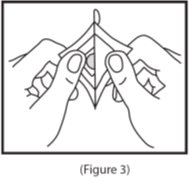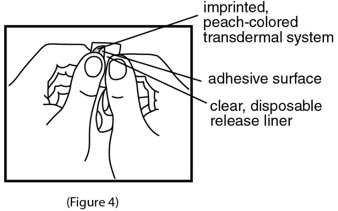Medication Guide
|
Scopolamine Transdermal System |
|
Read this Medication Guide before you start using scopolamine transdermal system and each time you get a refill. There may be new information. This information does not take the place of talking to your doctor about your medical condition or your treatment. |
|
What is scopolamine transdermal system? Scopolamine transdermal system is a prescription medicine used for adults to help prevent:
It is not known if scopolamine transdermal system is safe or effective in children. |
|
Who should not use scopolamine transdermal system? Do not use scopolamine transdermal system if you:
|
|
What should I tell my doctor before using scopolamine transdermal system? Before you use scopolamine transdermal system, tell your doctor about all of your medical conditions, including if you:
Tell your doctor about all the medicines you take, including prescription and over-the-counter medicines, vitamins and herbal supplements. Scopolamine transdermal system may affect the way other medicines work, and other medicines may affect how scopolamine transdermal system works. Medicines that you take by mouth may not be absorbed well while you use scopolamine transdermal system. Especially tell your doctor if you take:
Ask your doctor if you are not sure if your medicine is one that is listed above. Know the medicines you take. Keep a list of them and show it to your doctor or pharmacist when you get a new medicine. |
|
How should I use scopolamine transdermal system?
|
|
What should I avoid while using scopolamine transdermal system?
|
|
What are the possible side effects of scopolamine transdermal system? Scopolamine transdermal system may cause serious side effects, including:
The most common side effects of using scopolamine transdermal system include:
Tell your doctor if you have any side effect that bothers you or that does not go away. These are not all the possible side effects of scopolamine transdermal system. Call your doctor for medical advice about side effects. You may report side effects to FDA at 1-800-FDA-1088. |
|
General information about the safe and effective use of scopolamine transdermal system. Medicines are sometimes prescribed for purposes other than those listed in a Medication Guide. Do not use scopolamine transdermal system for a condition for which it was not prescribed. Do not give scopolamine transdermal system to other people, even if they have the same symptoms you have. It may harm them. You can ask your pharmacist or doctor for information about scopolamine transdermal system that is written for health professionals. |
|
What are the ingredients in scopolamine transdermal system? Active ingredient: scopolamine Inactive ingredients: peach-colored polyethylene/polyester film, polypropylene, povidone and silicone adhesive. The brown imprinting ink contains acrylic polymers, carbon black, iron oxides (red and yellow), polydimethylsiloxane, polyethylene wax, polytetrafluoroethylene, polyvinylpyrrolidone, sodium dioctyl sulfosuccinate and triethanolamine.
For more information, call Mylan at 1-877-446-3679 (1-877-4-INFO-RX). |
Instructions for Use
Scopolamine Transdermal System
(skoe polʹ a meen)
Read this Instructions for Use before you start using scopolamine transdermal system and each time you get a refill. There may be new information. This information does not take the place of talking to your doctor about your medical condition or your treatment.
Information about scopolamine transdermal system:
- •
- Scopolamine transdermal system is a peach-colored, circle shaped transdermal system (patch) with “Scopolamine 1 mg / 3 days” printed on it.
- •
- Wear only one scopolamine transdermal system at any time.
- •
- Do not cut scopolamine transdermal system.
To help prevent nausea and vomiting from motion sickness:
- •
- Apply one scopolamine transdermal system to your skin on a hairless area behind one ear at least 4 hours before the activity to prevent nausea and vomiting.
- •
- If the treatment is needed for longer than 3 days, remove scopolamine transdermal system from the hairless area behind your ear. Get a new scopolamine transdermal system and place it on the hairless area behind your other ear.
To help prevent nausea and vomiting after surgery:
- •
- Follow your doctor’s instructions about when to apply scopolamine transdermal system before your scheduled surgery.
- •
- Scopolamine transdermal system should be left in place for 24 hours after surgery. After 24 hours, scopolamine transdermal system should be removed and thrown away.
How to use scopolamine transdermal system:
Inside the scopolamine transdermal system package, you will find one scopolamine transdermal system. An imprinted, peach backing membrane with a sticky surface is adhered to a clear, disposable release liner (See Figure 1).
- 1.
- Select a hairless area of skin behind one of your ears. Avoid areas on your skin that may have cuts, pain or tenderness. Wipe the area of your skin with a clean, dry tissue.
- 2.
- Tear along the dashed line on the scopolamine transdermal system package to open (See Figure 2). Remove the contents of the pouch and discard the additional piece of clear protective film covering the transdermal system.
- 3.
- Remove the clear plastic release liner from the peach-colored round scopolamine transdermal system (See Figure 3).
- 4.
- Do not touch the adhesive (sticky) surface on scopolamine transdermal system with your hands (See Figure 4).
- 5.
- Apply the adhesive surface of scopolamine transdermal system firmly to the dry area of skin behind your ear. The imprinted, peach colored side of the transdermal system should be facing up and showing (See Figure 5). Wash your hands with soap and water right away after applying scopolamine transdermal system, so that any medicine from scopolamine transdermal system that gets on your hands will not get into your eyes.
How to remove scopolamine transdermal system:
After removing scopolamine transdermal system, be sure to wash your hands and the area behind your ear thoroughly with soap and water. Please note that the used scopolamine transdermal system will still contain some of the active ingredient after use. To avoid accidental contact or ingestion by children, pets or others, fold the used scopolamine transdermal system in half with the sticky side together. Throw away (dispose of) scopolamine transdermal system in the household trash out of the reach of children, pets or others.
How should I store scopolamine transdermal system?
- •
- Store scopolamine transdermal system at room temperature between 68°F and 77°F (20ºC and 25ºC) until you are ready to use it.
- •
- Store scopolamine transdermal system in an upright position.
- •
- Do not bend or roll scopolamine transdermal system.
Keep scopolamine transdermal system and all medicines out of reach of children.
The Medication Guide and Instructions for Use have been approved by the U.S. Food and Drug Administration
Manufactured for:
Mylan Pharmaceuticals Inc.
Morgantown, WV 26505 U.S.A.
Revised: 6/2019
SCOP:R8/MG:SCOP:R2




